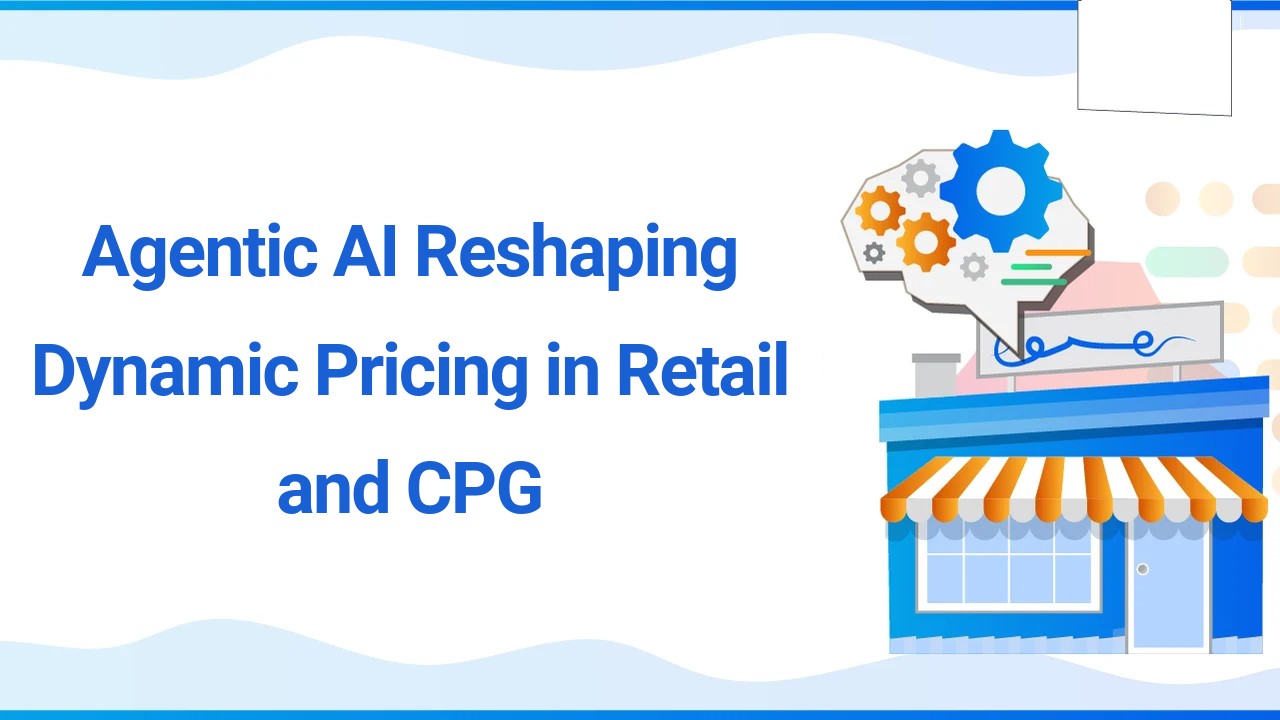With Agentic AI, pricing becomes more personalized as it tracks consumer preferences and purchasing behaviors. AI allows businesses to offer tailored pricing strategies that cater to different customer segments, improving satisfaction and loyalty. By providing consumers with customized offers, companies can enhance their shopping experience and build stronger customer relationships. Personalized pricing also increases conversion rates and sales.
What if pricing could be adjusted automatically, in real-time, based on every shift in the market? With the help of Agentic AI, this is now a reality for businesses in the retail and consumer-packaged goods (CPG) industries. Traditional methods of manual price setting are becoming obsolete, replaced by AI-powered dynamic pricing that enables businesses to adapt instantly to market conditions. From simple changes in customer traffic to existing competitor prices or market trends, this technology enables one to set their prices rightly in the market.
This blog delves into how it transforms pricing strategies, helping businesses become more agile, competitive, and ultimately more profitable in a fast-evolving marketplace.
What is the Dynamic Pricing Strategy?
Dynamic pricing strategy refers to adjusting product prices in real-time based on various factors such as demand, competition, time of day, and consumer behavior. This pricing model is especially useful in retail and CPG industries since market and consumer trends keep changing. Businesses utilize dynamic pricing in retail to optimize revenue by setting the best possible price based on predictive models and market insights.
In the consumer goods sector, dynamic pricing is used to help businesses adapt to market conditions, including raw materials or promotion needs, by making product prices that correspond to the current market. Businesses can boost sales, enhance customer satisfaction, and improve overall profitability by offering competitive prices that respond to supply and demand.
A Brief Overview of Dynamic Pricing Strategy in Retail and Consumer-Packaged Goods
An automated dynamic pricing strategy leverages algorithms, machine learning, and AI-powered dynamic pricing to adjust real-time pricing. Traditional dynamic pricing models relied on manual interventions or basic rule-based algorithms. However, the advent of AI agents in retail and CPG has transformed how prices are set by providing automated, real-time adjustments based on complex datasets.
With Agentic AI, businesses no longer rely on a single price point. Instead, they can employ sophisticated models considering demand elasticity, inventory levels, competitor prices, and market trends. This system allows for fine-tuning the price decision for many goods at once, guaranteeing that the price is optimal between the customer perceiving the price as fair, positioning on the market, and business outcomes.
Traditional vs. Agentic AI Dynamic Pricing Strategy
| Feature | Traditional Dynamic Pricing Strategy | Agentic AI-based Dynamic Pricing Strategy |
| Pricing Mechanism | Rule-based algorithms or manual adjustments | AI-driven algorithms that dynamically adjust prices based on real-time data |
| Speed of Adjustment | Slow, often requires manual intervention or batch updates | Real-time pricing adjustments are made automatically |
| Data Utilization | Basic market and competitor data | Utilizes large datasets including consumer behavior, competitor pricing, and demand signals |
| Scalability | Limited scalability, difficulty in handling large volumes | Highly scalable, capable of processing vast amounts of data in real-time |
| Accuracy of Price Recommendations | Based on historical data and basic rules | AI models refine pricing decisions through continuous learning and predictive analytics |
| Operational Efficiency | Dependent on human input and slower decision-making | Automates the entire pricing process, reducing human intervention and errors |
Agentic AI Multi-Agent in Action
Agentic AI utilizes a multi-agent framework to optimize dynamic pricing in retail and CPG. The architecture is designed to autonomously manage different pricing tasks and decisions, reducing human intervention and ensuring constant adaptation to market changes. The agents used by Agentic AI include:
- Master Orchestrator: The Master Orchestrator is the central unit that oversees and coordinates all the agents in the system. It ensures that each agent functions optimally and in correspondence with the strategic pricing plan and the key organizational objectives.
- Demand Estimation Agent: The Demand Estimation Agent predicts future product demand by analyzing consumer behavior, trends, and historical sales data. By predicting the level of demand, it offers the basic information that can be used to set realistic prices and control stock.
- Competitive Intelligence Agent: The Competitive Intelligence Agent continuously monitors competitor pricing and adjusts the pricing strategy to maintain a competitive advantage. It ensures that the business stays sensitive to competitors’ price changes and even general market trends, ensuring that the business does not fall behind in pricing.
- Inventory Management Agent: The Inventory Management Agent tracks stock levels and automatically adjusts prices based on inventory conditions. It helps avoid issues such as overstocking or stockouts by ensuring that pricing reflects the availability of products.
- Price Sensitivity Agent: The Price Sensitivity Agent quantifies the customer response to price changes through elasticity models. It uses price sensitivity to make the right price decisions that increase revenues without affecting the sales volume or the customers.
- Marketing and Promotions Agent: The Marketing and Promotions Agent integrates ongoing marketing strategies and promotional campaigns into the pricing framework. It ensures that discounts, seasonal promotions, or targeted offers are seamlessly incorporated into the dynamic pricing model to optimize results.
This orchestrated multi-agent system ensures that all dynamic pricing variables are accounted for in real time, leading to more effective and profitable pricing decisions.
Use Cases of Dynamic Pricing Strategy in Retail and Consumer-Packaged Goods
- Retail E-commerce: Dynamic pricing helps e-commerce businesses adjust to fluctuating demand. During peak seasons like Black Friday, AI-powered dynamic pricing enables retailers to modify prices based on inventory, market, and competitor strategies.
- Consumer-Packaged Goods: CPG companies adjust prices based on production costs, demand, and seasonal factors. For instance, beverage companies may increase prices due to rising raw material costs or holiday demand.
- Travel and Hospitality: Dynamic pricing is mainly adopted by the travel industry to facilitate price changes to booking trends, available demand, and weather factors. Today, airlines, hotels, and car rentals can adjust their prices depending on revenue targets.
- Subscription-Based Services: Subscription services use dynamic pricing to offer personalized plans based on customer usage and demand forecasts. This assists businesses in customer retention and increases profitability.
- Event Ticketing: Variable pricing changes prices based on customer demand, dependability, and seat availability. For example, ticket prices for concerts or sports events rise as demand increases.
- Online Marketplaces: If you are doing business on the web, for instance, on Amazon, you will find that products change their price frequently about competitor prices and customer searches. Sellers can remain competitive while optimizing their offers.
Operational Benefits of Dynamic Pricing Strategy
- Increased Revenue: AI agents can drive optimized pricing decisions for maximum profitability. By leveraging real-time data and consumer behavior insights, AI-powered dynamic pricing increases revenue by adjusting prices to meet market demand.
- Improved Productivity: By 2025, robotic process automation will directly control up to 80% of all pricing-related operations, freeing up business people and decision-makers to make strategic choices that do not require a lot of occasional, small-scale interaction.
- Enhanced Efficiency: The multi-agent framework used in Agentic AI improves pricing efficiency by automating decision-making processes, reducing human error, and ensuring faster responses to market changes.
- Better Customer Experience: By providing more relevant and timely pricing options, dynamic pricing in retail improves customer satisfaction. AI models can personalize pricing for individual customers, increasing loyalty and sales.
- Cost Savings: Applying dynamic pricing can also improve operational costs by minimizing most of the interferences from human beings while enhancing stock flow in firms. This ultimately results in a 15% reduction in its costs.
Technologies Transforming Dynamic Pricing Strategy with Agentic AI
- Machine Learning Algorithms: Machine learning algorithms enhance price-setting models by analyzing historical and real-time data. These models predict upcoming trends and customer behavior, enabling improved and flexible pricing.
- Natural Language Processing (NLP): NLP technologies are used for market sentiment analysis, customer reviews, and feedback on the social web. This enables firms to change the prices according to the customers’ feelings or moods, consequently enhancing the customers’ experience.
- Cloud Computing: Cloud computing enables businesses to process vast amounts of real-time data and scale their operations efficiently. It supports dynamic pricing by allowing quick and smooth updates in multiple channels and platforms.
- Big Data Analytics: Big data analytics processes large datasets, including customer behaviors, competitor pricing, and market trends. This provides businesses with actionable insights to optimize prices and improve decision-making.
- Edge Computing: Edge computing minimizes latency by processing data closer to the source, enabling quicker decision-making. This technology is especially useful for e-commerce, where real-time pricing adjustments are essential to maintaining competitiveness.
The Future Trends of Automated Dynamic Pricing Strategy
- Greater Integration with IoT: As more devices become connected, dynamic pricing in retail will increasingly rely on IoT data to set prices based on factors like product availability, demand, and location.
- More Personalized Pricing: Agentic AI will enable businesses to offer hyper-personalized pricing models based on individual consumer behavior, preferences, and purchase history.
- Real-Time Market Adjustments: As AI models become more sophisticated, dynamic pricing in CPG will be based on immediate, real-time market trends and even social media sentiments.
- Ethical and Transparent Pricing: With the growing use of AI agents, businesses will focus on implementing AI guardrails to ensure transparency and fairness in pricing decisions, reducing the risk of discrimination
Conclusion: Dynamic Pricing Strategy with Agentic AI
In conclusion, Agentic AI represents the future of dynamic pricing in retail and CPG industries. Businesses can achieve more accurate pricing decisions, improve efficiency, and optimize profitability by automating the pricing process. As AI agents continuously analyze data and adapt to changes in consumer behavior, market conditions, and competition, businesses can respond quickly and stay ahead of the curve. With these technological advancements, companies can offer more competitive prices while improving customer satisfaction. The future of pricing is undeniably AI-driven, and as this technology continues to evolve, businesses that adopt it will gain a significant edge in today’s fast-paced, data-driven market.



